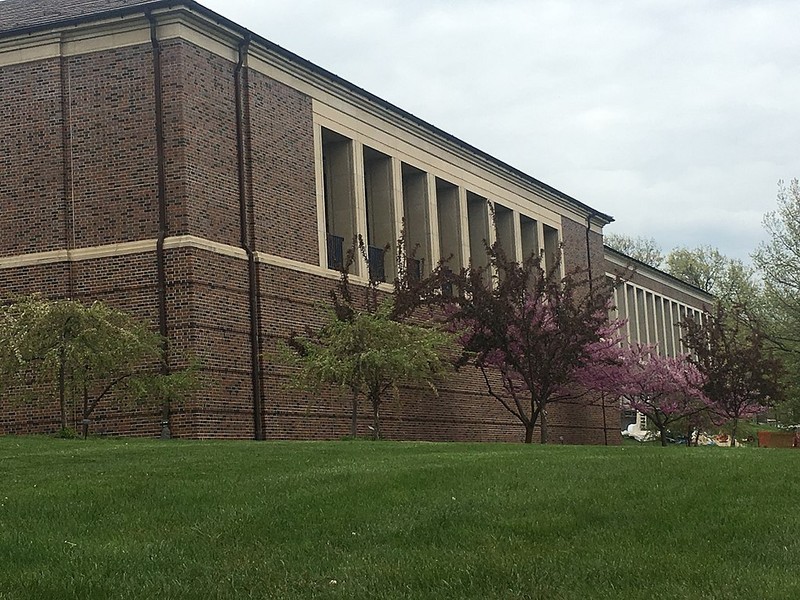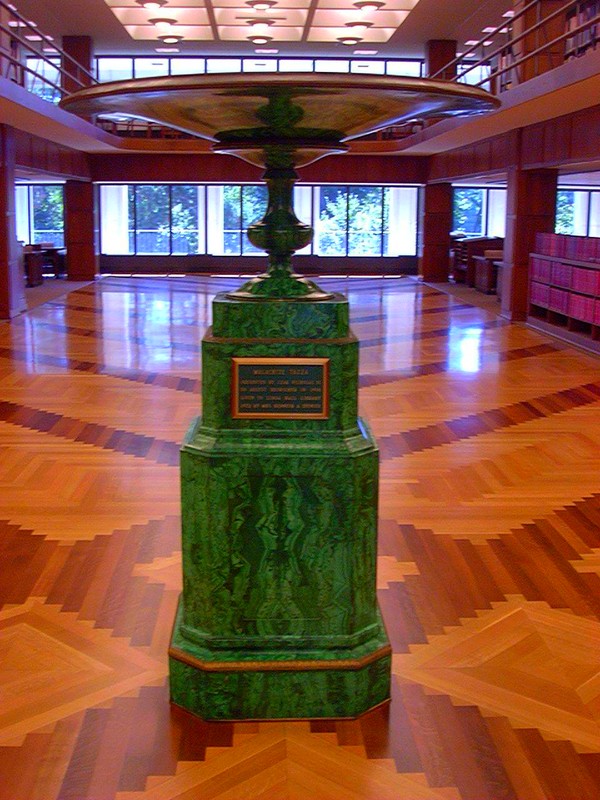Linda Hall Library of Science, Engineering, and Technology
Introduction
Text-to-speech Audio
Established in 1946 through a six-million-dollar gift from Herbert and Linda Hall, this independent science research library includes an arboretum. Both the grounds and the library are open to the public. One of the largest science libraries in the United States, the collection began with the acquisition of the library of the American Academy of Arts and Sciences in 1946. The availability and decision to acquire this collection shaped the direction of the library, which now also holds a sizable collection from the Franklin Institute and the Engineering Societies Library. The library holds over two million items, including a quarter million patents and records of leading scientific organizations. The collection is the largest of any private STEM-centered library in North America that is open to the public and is known for its collections related to the history of science and technology.
Images
Linda Hall Library is an independent organization on the UMKC campus and was established in 1946.

The tazza at the front entrance was a gift to the American Ambassador to Russia in 1910

1932 Photo of Linda Hall, the home of Herbert and Linda Hall

Notice in the University of Kansas City U-News Newspaper about the creation of the Linda Hall Library

Backstory and Context
Text-to-speech Audio
Originally from Maine, Herbert Hall got his first job working in a grain elevator in Chapman, Kansas. He later went on to co-found the Hall-Robinson Grain Company in 1887. Throughout his fifty-year career, he became one of the leading grain exporters in the United States and amassed more wealth for himself than most Kansans could dream of. He and Linda Southall, who were from Virginia, married in Kansas City in 1885. The two had no children and used much of their considerable wealth to support local philanthropy. Linda donated significant amounts to local hospitals to help women and children.
Herbert Hall and his good friend Edwin Shields, who ironically owned the competing Theis-Shields Grain Company, were two of J.C. Nichols' financial backers. Both men decided to build in Nichols' South Park neighborhood, which was designed for estates for the wealthy. The Shields family built their home in 1909, and the Halls built across the street in 1913. It was popular for the wealthy to name their mansions in those days. William Rockhill Nelson, owner of the Kansas City Star, named his mansion Oak Hall. The Shields' family home was known as Oaklawn. The Epperson family a block to the south named their home Hawthorn Hall. Herbert decide to name his home after his wife, Linda Hall.
Linda died in 1938, establishing in her will an endowment for a specialized free library. She requested that the library not be named for her. However, upon his death in 1941, Mr. Hall, who was by that point rumored to be the second richest man in Kansas City, left millions to Linda's library fund, instructing it to be named the Linda Hall Library. In consultation with the neighboring University of Kansas City, now UMKC, the trustees of the Hall estate decided the focus of the library should be science, the history of science and engineering. The university would then focus its library collections on the humanities and the health sciences. The university's students have always been welcome at the library and in the years before the construction of the Miller Nichols Library on the Volker Campus, the Linda Hall Library provided much needed study space for students. UMKC science and engineering students still are frequent patrons. The library opened in 1946 in the former Hall home, Linda Hall. The home was demolished and the current structure was constructed in 1964.
Today, the Linda Hall Library is internationally recognized for its science, engineering, and technology collection, serving researchers around the world. Despite being located on UMKC grounds, the library is not a part of the university; instead, it is independently funded and operated. Also on the library grounds is a small urban arboretum, which contains many varieties of trees and native plants.
Upon entering the library, visitors are greeted by a malachite tazza that was a gift to the American Ambassador to Russia from Czar Nicholas II in 1910. Helen Spencer discovered that this rare work had entered the private market and purchased it as a gift for Linda Hall Library. Additional treasures include a mid-19th century grandfather's clock that was designed by James Kenmuir, a hand-woven rug produced for a palace in China, and busts of famous scientists.
Sources
Our Story, Linda Hall Library. Accessed July 27th 2022. https://www.lindahall.org/about/our-story.
Wolff, Christopher. A Pearl of Great Value: The History of UMKC, Kansas City’s University. Kansas City, Missouri. UMKC Alumni Association, 2016.
History of the Linda Hall Library, Linda Hall Library. Accessed September 9th, 2022. https://libguides.lindahall.org/c.php?g=218603&p=1444309.
Linda Hall Library Guides, History of Linda Hall Library: Special Furnishings. Accessed October 4th, 2023. https://libguides.lindahall.org/c.php?g=218603&p=1444340.
"Big Library Gift." The Kansas City Star (Kansas City) December 9th, 1938. .1.
Walsh, John. Linda Hall Library: Kansas City Institution Builds a Reputation with Operations outside the Region. Science, vol. 148, no. 36731073 - 1075. Published May 21st, 1965.
Worley, William S.. J.C. Nichols and the shaping of Kansas City: innovation in planned residential communities. Columbia, Mo.. University of Missouri Press, 1990.
Decker, Mary Bell. Decker, Clarence Raymond. A Place of Light: the Story of a University Presidency. New York, New York. Hermitage House, 1954.
Kansas City Public Library, Missouri Valley Collection photo. https://kchistory.org/image/house-herbert-f-hall-0?solr_nav%5Bid%5D=a580e0d66005546124f0&solr_nav%5Bpage%5D=0&solr_nav%5Boffset%5D=2
The U-News, University of Kansas City, 03/03/1941 p.1
